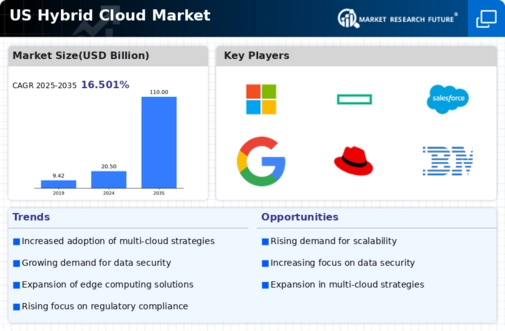Growing Demand for Scalability
The hybrid cloud market is experiencing a notable surge in demand for scalability, driven by organizations seeking to adapt to fluctuating workloads. Businesses are increasingly recognizing the need for flexible infrastructure that can accommodate varying data processing requirements. According to recent data, approximately 70% of enterprises in the US are prioritizing scalable solutions to enhance operational efficiency. This trend is particularly evident in sectors such as finance and healthcare, where data volumes are rapidly increasing. The hybrid cloud market is thus positioned to benefit from this demand, as it allows organizations to seamlessly scale resources up or down based on real-time needs, ultimately leading to cost savings and improved performance.
Enhanced Disaster Recovery Solutions
The hybrid cloud market is increasingly recognized for its robust disaster recovery capabilities, which are essential for business continuity. Organizations are gravitating towards hybrid solutions that offer reliable backup and recovery options, ensuring data integrity in the event of unforeseen disruptions. Approximately 60% of US businesses have reported that hybrid cloud strategies significantly enhance their disaster recovery plans. This trend is particularly relevant in industries such as manufacturing and retail, where downtime can lead to substantial financial losses. The hybrid cloud market is thus well-positioned to provide comprehensive disaster recovery solutions, allowing organizations to safeguard their critical data and maintain operational resilience.
Cost Efficiency and Budget Optimization
Cost efficiency remains a pivotal driver in the hybrid cloud market, as organizations strive to optimize their IT budgets. The ability to leverage both on-premises and cloud resources allows businesses to minimize capital expenditures while maximizing operational flexibility. Recent studies indicate that companies utilizing hybrid cloud solutions can reduce their IT costs by up to 30%. This financial incentive is particularly appealing to small and medium-sized enterprises (SMEs) in the US, which often operate with limited budgets. The hybrid cloud market thus presents a viable solution for these organizations, enabling them to access advanced technologies without incurring prohibitive costs, thereby fostering innovation and growth.
Regulatory Compliance and Data Sovereignty
As regulatory frameworks evolve, the hybrid cloud market is becoming increasingly vital for organizations aiming to achieve compliance with data protection laws. The need for data sovereignty is particularly pronounced in sectors such as finance and healthcare, where sensitive information must be managed in accordance with stringent regulations. Approximately 75% of US enterprises are prioritizing compliance as a key factor in their cloud strategy. The hybrid cloud market offers a flexible approach, enabling organizations to store data in specific jurisdictions while leveraging the scalability of cloud resources. This adaptability is crucial for maintaining compliance and mitigating legal risks associated with data breaches.
Innovation in Cloud Services and Technologies
The hybrid cloud market is witnessing a wave of innovation, driven by advancements in cloud technologies and services. Organizations are increasingly adopting hybrid solutions to leverage cutting-edge tools such as artificial intelligence and machine learning, which enhance operational efficiency and decision-making processes. Recent data suggests that nearly 65% of US companies are investing in hybrid cloud technologies to stay competitive in their respective markets. This trend is particularly evident in sectors like technology and telecommunications, where rapid innovation is essential. The hybrid cloud market is thus positioned to facilitate this technological evolution, providing organizations with the necessary infrastructure to harness the power of emerging technologies.























Leave a Comment